An analog or digital scale for weighing is a very popular measuring instrument used to measure the mass or weight of a body. Almost everything today is measured in terms of its weight.
Some of the Importance of using a weighing scale involves the following:
- If you go to a market or groceries, most of the things you buy are priced based on their weight. ..
- When you drink a medicine, like in a capsule form, it is measured in weight, usually in the unit of grams..
- When I was a cook (yes, one of my previous career), we always use a scale for weighing food tp pre-portion the ingredients to be cooked.
- During a check-up in a clinic, doctors measure our body weight first before other diagnostics and so on.
We can see how important and critical a weighing scale is. This is why it is important also that the weighing scales we use are accurate. How can we determine the scale accuracy? —through calibration.
In this article, I will share with you how to calibrate a digital scale to determine its accuracy in three simple methods; we will concentrate on the calibration of a weighing scale in the digital or electronic type.
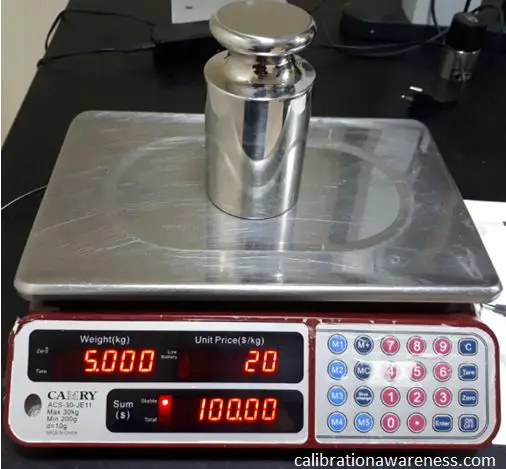
This procedure can be used in your internal calibration laboratory to calibrate most of your digital weighing scales.
This is not just a simple or basic procedure, wherein we will just compare a reference standard in one setup or position and then finish (compared to verification only).
You will discover here a scale calibration procedure where most capabilities, especially a digital weighing scale, will be checked for accuracy.
Why calibrate a weighing scale?
Just like other electronic equipment, it has a component that will be exposed to environmental stress like temperature, humidity, and vibration. This exposure plus aging will cause a digital weighing scale to encounter a drift.
Another reason is, that a digital weighing scale has a sensor, which is usually known as a load cell that can also drift because of the compression and contraction of its parts every time it is used.
Moreover, this is special to balances, wherein transferring the balance from one place to another has an effect on its accuracy. Unless it is verified that transferring to different locations has no effect, the balance should be calibrated only in the location where it is being used.
Additional reasons why we perform a balance calibration includes:
- Changes in environmental conditions like temperature and humidity
- After a repair or adjustment.
- Harsh usage
- Change in range of usage.
- Undesirable reading
Digital Weighing Scale Calibration Procedure
This procedure applies to all digital weighing scales, analytical balance, or a top loading balance which is generally termed a Non-Automatic Weighing Scale (NAWS) with a maximum capacity of up to 50 kilograms.
How to calibrate a digital scale? The calibration of scales with weights is performed by comparing the display of the balance to the display of the reference standard weights.
The digital scale calibration is performed in different techniques (3 methods) that you can see below, where every possible position and performance is checked for accuracy.
Things to consider:
- Weighing scale calibration should be performed preferably on its exact location, the location where it is being used. This is to prevent environmental effects such as the local gravity, temperature, and strong vibrations that affect its physical condition during the transfer.
.. - Allow proper stabilization time, and power up the electronic balance at least 30 minutes before performing the calibration.
.. - Perform on a leveled surface or level the balance using the bubbles installed in it (if available).
Objective
To calibrate a digital weighing scale to ensure the accuracy of its reading by using calibrated reference standard weights.
Requirements
- Warm-up time (UUC): At least 1 hour for proper stabilization
- Temperature: 23 +/- 5 deg C
- Humidity: 50 +/- 30%
- Measurement Data Sheet (MDS)
Reference Standards to be Used
- Set of Standard weights –It should cover the full range or capacity of the weighing scale. The standard weights for scale calibration should be appropriate to provide the best results. How to determine the appropriate reference standard weights? Check out my other post HERE.
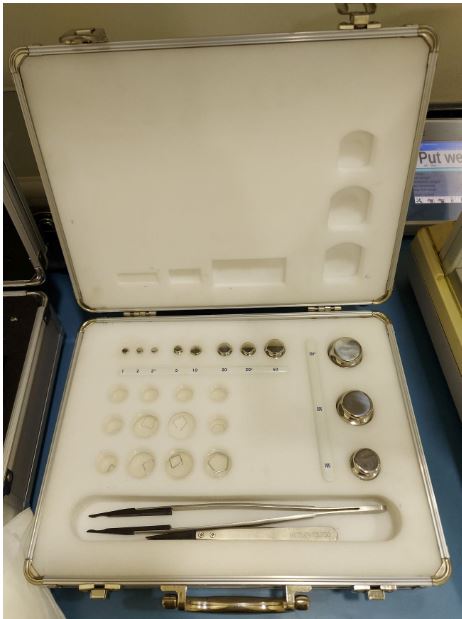
Other Materials include gloves or tongs for handling weights, cloth for cleaning
Scale Calibration Procedure
- Check the digital weighing scale for any visual defects that can affect its accuracy. Discontinue calibration if any defect is noted.
.. - Carefully clean the weighing scale, most weighing scale pans can be removed for better cleaning. Check for batteries (for battery-operated balances) to ensure accurate display and functionality.
.. - Level the balance, most balances have a stand that is adjustable to meet the proper level, use the bubble as a guide. See image.
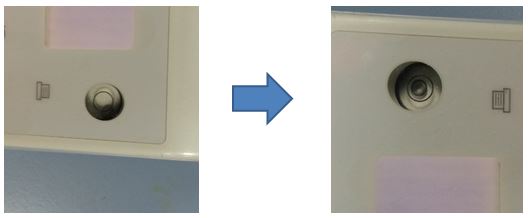
- Ensure that the area has no vibrations and strong air movement. (use a good cover if available)
4. Prepare the measurement data sheet (MDS) and record all necessary details or information (Brand, Model, serial #, etc). See this link to learn about MDS for you to create your weighing scale calibration format or template for a faster recording of data.
**For a weighing scale calibration format, you can use the 3 methods below as its content under the ‘Calibration results’ section.
5. Zero the scale. (push the zero button)
6. After zeroing, load a standard weight that is 80% of the capacity of the balance. This is the initial test for its accuracy. Record this as the “as-found” in your datasheet. If an error is observed, perform an adjustment immediately if possible (read down below about balance adjustment).
Now, we will perform the calibration of scales with weights to verify their accuracy under different conditions or methods through the following performance test:
1. Repeatability Test
This method will test how consistent is the balance in displaying the reading.
1.1 Load the pan with a standard weight that is 50% of the capacity of the balance.
1.2 Wait for the reading to stabilize (others have annunciator or a beep)
1.3 Once stabilized, record the reading on the MDS.
1.4 Remove the weights, Re-zero and repeat for at least five (5) times.
2. Accuracy Test or Departure from the Nominal Value
This method will test how accurate the displayed reading is in various ranges of weights until the full capacity.
2.1 Divide the full range of the balance to at least 5 or use 5 set points depending on the availability of weights until the full range is reached. ( from min to max)
2.2 Load the pan with the first standard weight
2.3 Wait for the reading to stabilize
2.4 Once stabilized, record the reading on the MDS,
2.5 Remove the weights, Re-zero and place the next weight.
2.6 Repeat procedure 2.1 to 2.5 until the full range is reached.
3. Off-center Loading
This kind of test is also known as the Eccentricity Test.
This method will test the accuracy of the pan just in case the weights are placed off the center. This test will show us if the corner-load error is negligible or has a high effect on its accuracy.
We will use a single weight that is nearly 1/3 the capacity of the balance. For example, if the capacity is 1200 grams, we will use a 400 grams weight (1200/3).
Follow the below position (1. Center, 2. Back, 3. Front, 4. Left and 5.Right):
3.1 After zeroing, load the pan with the required weights in the first position (center)
3.2 Once the readout has stabilized, record the result on the MDS.

3.3 Remove weights, re-zero, and transfer to another position.
3.4 Repeat until all positions are done.
8. End of procedure.
Finalize your results and create the calibration report. Check the content of an ISO 17025 calibration certificate in this link >> Accredited calibration certificate
2 Types of Adjustments in Digital Weighing Scale (DWS) Calibration
Scale adjustment is needed once we verify that our DWS is showing a large error or an error that exceeds our tolerance limit.
Most of the electronic or digital weighing scales today are programmable where auto-calibration can be performed. This means that it can be adjusted automatically with a push of a button. Once the calibration menu is unlocked or open, adjustment can be done by using the standard weights.
The principle is that the unit will require or search for an exact weight as a reference to be programmed internally. This procedure depends on the model of the weighing scale so be sure to have a manual while performing a calibration.
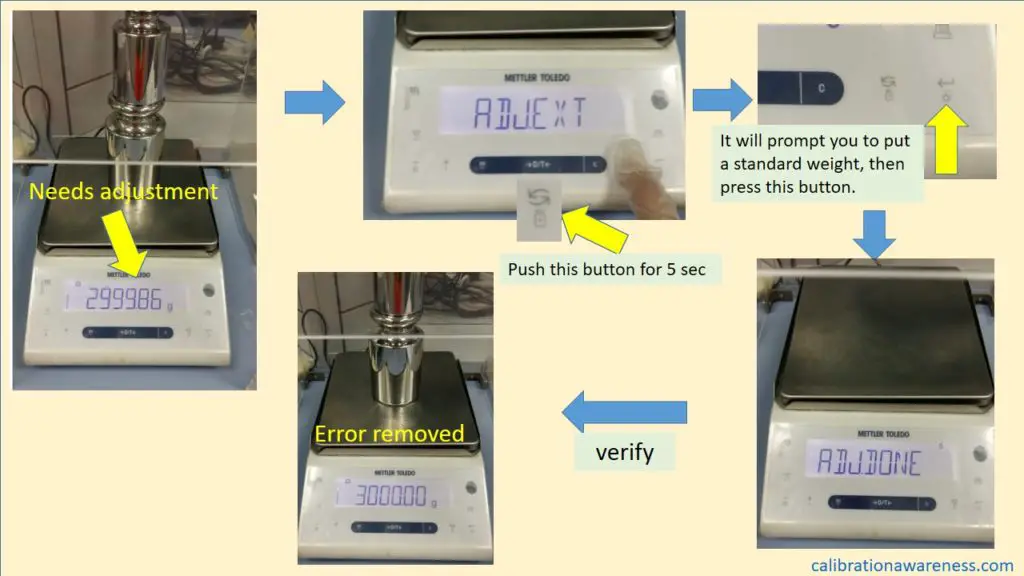
For me, the most fulfilling instrument to calibrate is the digital weighing scale. Why? As per experience, you can see the actual adjustments and removal of the error. You can return the instrument in its most accurate range with almost no error at all (visually).
There are 2 ways where we can perform an adjustment, either by
- internal adjustment
- external adjustment
These types of adjustments in balance calibration are also known as ‘internal calibration’ and ‘external calibration’. It is termed as ‘calibration’, but in a real sense, it is a method of a weighing scale adjustment because it brings back your scale to its most accurate performance.
Remember that during the execution of any adjustment (internal or external), the adjustment factor that is stored in the system will be changed once you push the accept button.
Before performing a balance adjustment, you must know the tolerance of your weighing scale. If you do not know your tolerance limit, visit my other post here for a calculation guide >> determining the tolerance limit of a weighing scale
Note: I get commissions for purchases made through links in this post.
Internal Calibration Vs. External Calibration in a Digital Weighing Scale
Internal Calibration
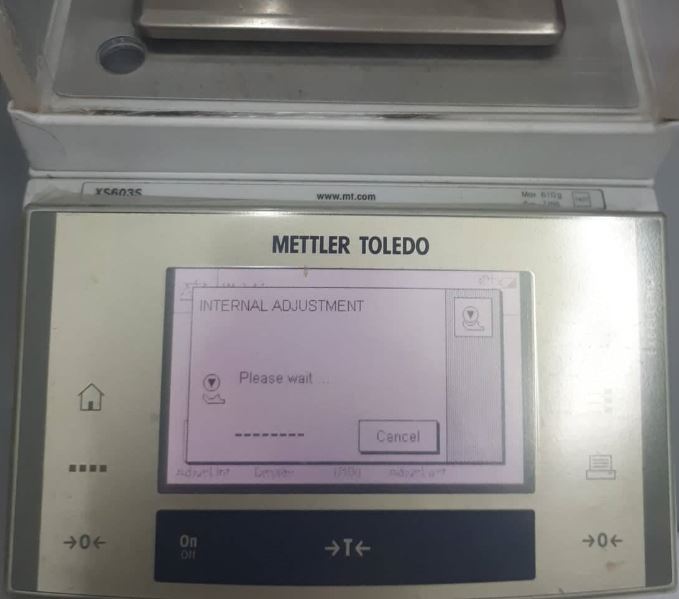
Internal calibration also known as the internal adjustment is an adjustment using the internal weights installed inside the weighing scale. There is no need to load standard weights.
It is an automated adjustment where the DWS is adjusted just by a press of a button.
The digital weighing scale will detect the zero load of the pan then it will use the internal weights installed to perform an adjustment or calibration. Once executed, there are no other steps to be done, but to wait for the final settings to be saved.
When to use internal calibration?
Internal calibration is usually used every time a DWS is transferred from one place to another, a big change in environmental conditions or a suspected deviation in readings.
But be sure to have standard weights with you every time you perform this to verify that errors are removed or within an acceptable range. If you do not need a set of weights, at least use standard weights that are equal or near to the range that you are using.
The disadvantages of this method of adjustment are:
> The adjusted range is limited and therefore the accuracy
> since the internal weight is not certified, there is no traceability of the performed calibration
> once you have executed this adjustment in the balance, it will delete the past calibration settings and therefore invalidate the performed past calibration.
Advantages of Internal Calibration of a Weighing Scale.
External Calibration
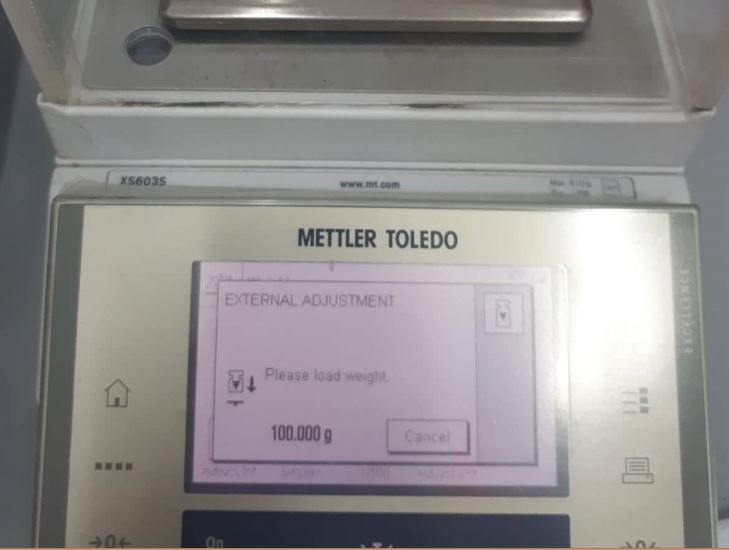
In External calibration or external adjustment of a weighing scale, we will need a set of weights, depending on the range that is required or programmed in the DWS.
We will load the weights manually on the pan of the DWS to perform the adjustment. The DWS will prompt you on what range of weights you need to put in its pan (or depending on what range you have programmed).
External calibration of balance is used during scheduled calibration (full-range or what is required as per user) to ensure a traceable calibration.
Advantages of External Calibration or Adjustment
Remember that every time an adjustment is executed, do not forget to perform balance verification.
Take note that not all electronic weighing scales or balances are adjusted successfully even if you performed the above scale adjustment method. One reason is that the load cells are already defective where a scale calibration service by a 3rd party is needed, usually the OEM for repair or replacement of load cells.
Conclusion
I have presented in this article the procedure for calibrating a digital weighing scale that you can use for your in-house calibration. Weighing scale calibration requires only standard weights but be sure to use the proper weights (class of weights) by considering the specifications of the balance (accuracy and resolution).
We discussed here the different methods to test the accuracy of a weighing scale. These are the repeatability test, accuracy test for defined nominal ranges, and the off-center loading also known as eccentricity.
Each one of these has its own requirements in order to determine how accurate your weighing scale is.
Furthermore, I have explained the terms used during adjustments, which is the internal and external calibration, also known as internal and external adjustments. I have presented its meaning and some advantages of each use.
Thank you for visiting my site.

If you like this article, I appreciate if you could please share, subscribe and Buy Me A Coffee.
You can also connect with me on my Facebook page.
Best Regards,
Edwin

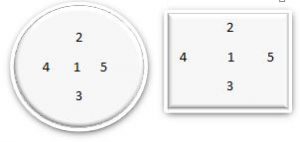
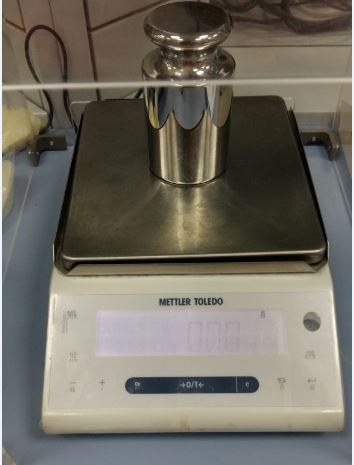
29 Responses
Kourtney Jensen
I have had my balance for a while now and haven’t had it calibrated. I wonder if it’s still calibrated correct. This was very informative and made me realize the importance of doing so! You mentioned that so many things are measured in weight now and I never realized that until reading this. Weight being off can make a big difference in the food market and also in the science field with medication and chemicals. If one number is off, it can throw everything off. I’ll be sure to pass this information on to my husband so that he knows the importance of having our balance calibrated!
edsponce
Hi Ms. Kourtney,
Good Day! I appreciate that you read my post and had taught you something.
Yes you are correct.This is one of the importance of calibration not just in manufacturing areas but in our daily lives as well. By knowing how accurate the instrument we use gives us the assurance of quality, reliability, and fairness to everyone whenever we use it. If you own a balance and you want to verify it personally if it is reading accurately without using a standard weights, you may visit one of my post here. https://calibrationawareness.com/verifying-a-weighing-scale-by-using-a-bottled-water
Just let me know if ever you or your husband has a question about balance calibration.
Thank you and Best Regards,
Edsponce
Hiteshkumar Maganbhai Patel
Thank sir its very useful to me
edsponce
You’re welcome Sir, I am glad that my post has helped you.
Best Regards,
Edwin
John Smith
Very useful article. Thanks. I actually find that hiring professionals to take care of calibration needs gives me greater peace of mind. And with services like Calibration Program Management, a business can get turnkey solutions that actually free up resources that can then be invested in the core business.
edsponce
Hi Sir,
Thanks for the comment. I agree with you. Managing a calibration program has a lot of things to consider both technical and in the documentation part.
Best regards,
Edwin
M.Saravanan
Hi sir thank you for a clear informative presentation. It was very useful for our PG students for routine calibratione. Good job.
edsponce
Dear Mr. Saravanan,
You are welcome Sir, Happy to help. Appreciate your comment.
Thanks and regards,
Edwin
Vinod
Hi Sir, I go through your post and its fantastic.can you help me the calculation or measurements uncertainty for digital pressure gauge, calibration using hydraulic pressure comparator. Please sir
edsponce
Hi Mr. Vinod,
I am happy to help. Do you have some background on how to calculate measurement uncertainty?
Thanks and regards,
Edwin
Vinod Kumar
Yes Mr. Edwin, I am well aware for electro-technical calibration.
edsponce
Hi Mr. Vinod,
Nice to know. I could ask for some support one day.
Thanks and regards,
Edwin
Dingiswayo
Goodday,
Your article is very refreshing and informative. Enjoyed reading through it, good job!
Thank you very much
edsponce
Hi Sir,
You are welcome. Thank you for the time spent in reading my post. I appreciate your comment.
Best regards,
Edwin
Ansul
Calibration is important task to do while working with weighing machine. People tend uninformed about this. You write the best article for this problem. Keep writing.
edsponce
Hi Mr. Ansul,
I agree more with you.
Thank you for visiting my site.I appreciate your comments.
Best Regards,
Edwin
Ron Booker
I like that you said that when weighing scale calibration should be performed on an exact location to prevent effects as local gravity, temperature, and vibration. One of my friends told me that he has an electrical tool in his garage that needs to be repaired. I’m going to check online for a tool repair service.
edsponce
Hi Mr. Ron,
Yes, one of the requirements that we should consider in weighing scale calibration. Thank you for reading my post. Hope you will find the repair service you needed.
Best regards,
Edwin
Tosin
Great Post. Weldone!
edsponce
Thank you.
zaman
Your Lesson of Calibration is great easy and simple understandable.
Thank you for your publish. Please keep continue with something new.
edsponce
Hi Zaman,
You are welcome. I appreciate your comments. I will continue writing as long as someone like you appreciates it.
Thanks and regards,
Edwin
Marie C. Vazquez
Calibration is important task to do while working with weighing machine. People tend uninformed about this. You write the best article for this problem. Keep writing.
edsponce
Hi Marie,
I Agree! Thanks for the comment.
Happy New Year!
Edwin
Swisser Instruments Pvt.Ltd
You shared a great article with us. This information is beneficial for those who are working in the same industries. Last month, I read Weighing Scale blogs that were amazing. I think you should visit them. Keep sharing more articles.
edsponce
Hi,
Thank you for visiting my site. Very much appreciated it if you could share this on your website as well.
Best regards,
Edwin
Mohammad Aun
Hi ed
just read your blog for weighing balance calibration, very nicely explained.
as i know, internal & external calibration set-up is different for different types of balance
as per manufacturer, and sometimes manual is not available for the same.
Ram Shankar Pal
True ,It’s very useful blog to user of weighing machines basically for laboratory purpose.before using the scale user are advise to calibrate the scale before use time to time.user have standard weights duly calibrated by relevant authority.
VIDMate
Great tips on calibrating digital weighing scales! I especially appreciated the emphasis on regular checks to maintain accuracy. It’s easy to overlook, but essential for ensuring precise measurements. Thanks for the helpful insights!